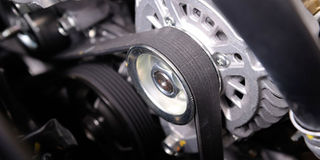Know your timing belt and chain

Timing chains are generally more durable than timing belts – though neither is as durable as direct gear drive – however, timing belts are lighter, less expensive, and operate more quietly. Photo by Dominic Bukenya
What you need to know:
- If you own a car, you must know some of the sensitive parts that unprofessional mechanics will take advantage of and charge you excessively. Today, we explore what a timing chain and belt are and why you need to know what it does and how often to change them.
According to Bosco Kigongo of Icony Garage, timing belts are made of rubber which is reinforced with steel wire. Because the belts are flexible and there is no metal on metal contact, it eliminates the need for lubrication. On the other hand, timing chains are made of metal and resemble the chains on a bicycle and motorcycle.
Kigongo adds that timing chains and belts perform the same function, to connect the camshaft and the crankshaft to keep them rotating systematically. However, despite having the same functionality, they are unique in design and each have their own benefits as well as disadvantages.
As they have the same function Kigongo says an engine will be fitted with one or the other (there are a handful of engines that have both).
Timing belts and chains are generally not visible when you open the bonnet as they are protected by metal or plastic covers to guard them from dust or debris.
Kigongo says an engine is essentially split into two halves, the top half (comprising the cylinder head and others) and the bottom half (comprising the cylinder block, crankshaft and pistons) The top and bottom halves of the engine must rotate precisely in time with each other and it is the responsibility of the timing belt or chain to ensure this happens. If the timing goes out of sync by even a couple of degrees (due to a worn timing belt/chain or one that was set up incorrectly in the first place) the engine will not run smoothly.
Maintenance and replacement
Ronald Lubega of Grace Lubega Motors in Rubaga, Kampala, says just like in other car parts, the timing belt and chain need maintenance and replacement. He adds that majority of manufacturers recommend changing the timing belt between 60,000 and 100,000 miles, although it is important to check with your manufacturer to find out the exact recommendation.
He says since timing belts are fed through a series of pulleys and tensioners in the engine system, it is important that these are replaced at the same time as the belt. It is also good to change the water pump at the same time since it has done as much work as the belt. “In newer cars the water pump is often installed behind the belt so the belt has to be removed to change it. In other words, you may as well change the water pump since the belt is being changed,” he says.
Timing chains
Lubega adds that since there is metal on metal contact, the chain runs through the inside of the engine so it can be lubricated by engine oil. “As a general rule, timing chains only need to be replaced if there is a problem with it,” he says adding: “Their main benefit is that they last for a long time. Some disadvantages of timing chains include the louder noise level and the damaging impact from one if it breaks.”
Similar to timing belts, they are fed through a series of tensioners and pulleys to keep them under the optimum level of tension. Timing chain tensioners rely on engine oil pressure, if for any reason the oil pressure is low the chain tensioners can lose pressure and it will offset the engine timing. This results in poor engine performance and the chain may malfunction causing expensive damage.
Timing chains usually have no connection to the water pump unlike timing belts so they do not need to be replaced at the same time.
Other ways of proper maintenance are use of the correct specification of engine oil for your vehicle, Changing oil and oil filters at the recommended intervals and having any unusual sounds in the engine checked.
Signs and symptoms of a faulty timing belt
When you have a bad timing belt or chain, there will be some obvious symptoms. Below are some. Bosco Kigongo, a mechanic, says one of the most common symptoms of worn timing chains is noise. Worn timing chains can become loose and it can hit off the rails as it rotates. It can also result in some debris around the engine as it hits off the cover. He advises that rattling timing chain is usually on the verge of breaking down and should be replaced immediately.
Engine misfire
Kigongo says that since a bad timing belt can reduce the firing rate of the engine, it will likely cause the engine to misfire. This will happen if a worn-out timing belt slips off its pulley and falls onto the camshaft drive. Then the timing of when the cylinder opens and closes would be thrown off, which would cause a misfire for sure. Kigongo says if it is not replaced, the engine will suffer irreversible damage.
Rough Idling
“Car idling is in most cases is supposed to be peaceful “says Kigongo. However, if your timing belt has worn out or missing teeth, then it will likely slip out of its position and fall onto the other gears. The timing will then be off on the camshaft, resulting in the engine stopping.
Broken Valves or Pistons
Ronald Lubega, a mechanic says when there is no smooth or easy rotation of crankshaft and camshaft, the piston could get damaged and end up bending the valves as it comes in contact with them. The most common reason for this happening is when the timing belt totally snaps apart. The only thing you can do at this point is to install a new timing belt before the engine gets seriously damaged.
Low oil pressure
Lubega says as a timing belt starts to get excessively worn-out, pieces of its teeth will come loose and break off into the oil pan of the vehicle. This will cause a significant drop in the oil pressure of the engine. Once that happens he advises reconstructing the whole motor.
Ticking sound
Lubega says the timing belt is connected to lots of pulleys and is surrounded by lots of components. If the timing belt is worn out, it will start to become loose and possibly make a ticking sound as it continues to wear out. The sound will remain there until the timing belt gets so worn that it breaks apart.
[email protected]




